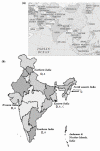An overview of molecular epidemiology of hepatitis B virus (HBV) in India
- PMID: 19099581
- PMCID: PMC2640379
- DOI: 10.1186/1743-422X-5-156
An overview of molecular epidemiology of hepatitis B virus (HBV) in India
Abstract
Hepatitis B virus (HBV) is one of the major global public health problems. In India, HBsAg prevalence among general population ranges from 2% to 8%, placing India in intermediate HBV endemicity zone and the number of HBV carriers is estimated to be 50 million, forming the second largest global pool of chronic HBV infections. India is a vast country, comprised of multiracial communities with wide variations in ethnicity and cultural patterns, which is attributable to its geographical location, gene influx due to invasion and/or anthropological migrations in the past. Moreover, recent increase in trade, trafficking and use of illicit drugs has also considerably influenced the epidemiology of HBV, specifically in the eastern and north eastern parts of India. However, data on the molecular epidemiology of HBV in India is scanty. HBV genotypes A and D have been well documented from different parts of mainland India. Interestingly, in addition to genotypes A and D, genotype C having high nucleotide similarity with south East Asian subgenotype Cs/C1 strain, have been detected exclusively from eastern Indian HBV carriers, suggesting a recent introduction. Thus, compared to other parts of India, the molecular epidemiology of HBV is naturally distinct in eastern India. Very recently, taking the advantage of circulation of three distinct HBV genotypes within the population of eastern India, different aspects of HBV molecular epidemiology was studied that revealed very interesting results. In this study, the clinical significance of HBV genotypes, core promoter and precore mutations, possible routes of introduction of HBV genotype C in eastern India, the clinical implications of x gene variability, prevalence of the AFB1 induced p53 gene codon 249 mutation, the transmission potentiality of HBV among asymptomatic/inactive or occult HBV carriers and the genetic variability of HBV persisting in the PBL was investigated. In this manuscript, the information available on the molecular epidemiology of HBV in India has been reviewed and the results of studies among the eastern Indian population have been summarised.
Figures


References
-
- Hepatitis B. Fact sheets WHO http://www.who.int/mediacentre/factsheets/fs204/en
-
- Ganem D, Schneider RJ. Hepadnaviridae: the viruses and their replication. In: Knipe DM, Howley PM, editor. Fields Virology. 4. Philadelphia: Lippincott Williams & Wilkins; 2001. pp. 2923–2969.
Publication types
MeSH terms
LinkOut - more resources
Full Text Sources
Medical
Research Materials
Miscellaneous

